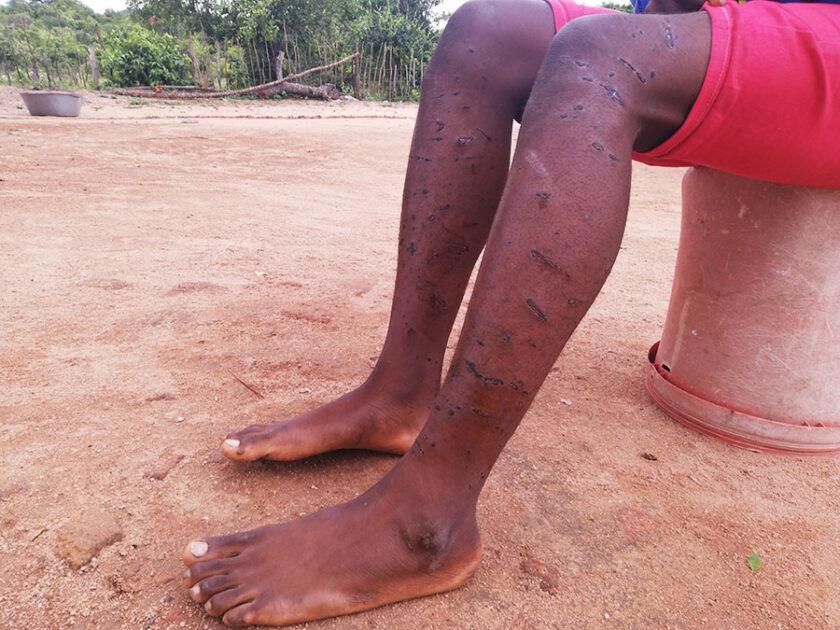Zimbabwe’s diamonds bring wealth for a few, despair for many

The arrival of huge mining corporations has left thousands in Marange feeling like prisoners in their own ancestral land.

A tiny bridge which connects Masvingo road and the diamond mining fields via Odzi River. Credit: Farai Shawn Matiashe.
Trevor Kusena, 19, struggles to walk from his cottage to the veranda at his family home in Betena, a village in Marange, eastern Zimbabwe. As soon as he sits down, a dog from the neighbouring house starts barking.
Kusena recoils as the sound immediately brings back traumatic memories of his ordeal this January when he was set upon by guard dogs belonging to the state-owned Zimbabwe Consolidated Diamond Company (ZCDC).
“I left the house to get our herd of cattle that had entered ZCDC premises when I came face to face with three guards,” he recalls. “One of the guards pounced on me and started squeezing my neck with his right hand while I was lying down. Two dogs, German Shepherds, started biting both of my legs.”
The patrollers accused the young local of trespassing on ZCDC land. Kusena says his cattle may have strayed onto the company’s premises but only because it is not fenced off as it should be, and that he was just there to bring the herd back.
Either way, the guards beat him until he could barely move and in need of hospital treatment.
“They left me for dead,” says Kusena.

Trevor Kusena is recovering from the wounds he was bitten by ZCDC’s dogs in Marange. Credit: Farai Shawn Matiashe.
For many of the thousands of Zimbabweans living on the Marange Diamond Fields, Kusena’s story is all too familiar. They say that since the government forcibly took control of the diamond mines to make way for big corporations in the late-2000s, they have felt like prisoners in their own ancestral lands.
In some ways, their plight began when Marange was discovered to have one of the world’s richest diamond deposits in June 2006 and, over the next two years, 30,000 small-scale miners flocked to the area. This led to a water, sanitation, and housing crisis, as well as a rise in black market smuggling and violence as politically influential figures allegedly took control of the illegal extraction.
However, matters got worse in some respects when the Zimbabwean government decided to eliminate artisanal mining and pave the way for large mining companies. There had been various crackdowns on small-scale miners over the previous years, but in November 2008, the government deployed the military to carry out Operation Hakudzokwi (“No Return”). Security forces were reportedly ordered to shoot miners on sight, killing over 200 people.
In 2009, the government also relocated around 5,000 people from the village of Chiadzwa to a new location in Transau. The villagers were told that mining companies would provide them with arable and grazing land, $5,000 compensation, and establish homes, schools, and other infrastructure for them. Yet those relocated say the houses and schools they were built were low quality, that only got a fraction of the compensation at best, and that basic infrastructure like electricity has never been provided.
The neglect of this part of Manicaland Province can be seen in the dilapidated roads and deserted markets that had been vibrant during the era of small-scale miners. Apart from a few boreholes drilled by NGOs, there is little access to water or to electricity. Some children in Marange have to walk 10km to reach the nearest secondary school.
“We have no tarred roads, no electricity, schools and clinics are far away. This whole village has one borehole,” says Kudzai Maphosa, 32, from Dzoma village. “We cannot even afford three meals per day.”
“These diamond mining companies are failing to cohabit with the locals,” adds James Mupfumi, director of Centre for Research and Development (CRD), a trust based in Mutare. “Locals do not have farming land because that land is part of the diamond mining fields.”
To add insult to injury, the surrounding area is also now dotted with security checkpoints that villagers need permits to pass through. And straying onto company land can lead to harsh beatings, as Kusena found out.
“This is what they do,” says Kusena’s mother Linace Gondo, 39, holding back the tears. “After unleashing their dogs on our children, they leave them for dead. If you make a report they do not even apologise or compensate.”
Zimbabwe’s Ministry of Mines and Mining Development and the companies ZCDC and Anjin did not respond to repeated requests for comment.
Following some upheaval in recent years, the Marange diamond fields are currently mined by two companies: the state-owned ZCDC; and Anjin, a joint venture between Chinese company Anhui Foreign Economic Construction Group and the Zimbabwean military’s investment vehicle Matt Bronze.
In 2016, Anjin had been expelled from Marange, along with several other companies, after then President Robert Mugabe accused it of having looted diamonds worth $15 billion, a claim it strongly denied. Yet to many people’s dismay, the government readmitted Anjin in 2019. And in early 2021, it returned the company the country’s most lucrative diamond-producing block.
Last year was also notable for a series of protests in Marange, organised by community leaders and civil society organisations. In November 2021, for instance, 29 villagers were arrested for an allegedly unplanned demonstration against Anjin’s initiation of a beer ceremony, a traditional ritual meant to appease spirits to bring more diamonds, without consulting the community.
Locals’ aspirations, however, go much further. Many people insist that profits from the diamond industry ought to benefit the local area. In 2021, ZCDC made an estimated $60 million net profit after it exceeded its production targets, yet little of this is likely to be seen in either local development or in the pockets of most workers who have complained of low salaries.
Jey Kasakara is the chairperson of the Marange chapter of the Amalgamated Chiadzwa Development Communities Trust, a group that advocates for communities to benefit from mining. He says that a major hurdle comes from the fact that Zimbabwe’s law is vague regarding how communities are meant to benefit from the resources extracted on their ancestral lands.
“There is no legal framework which protects the villagers to ensure that they are not deprived of benefiting from the gems being mined from their ancestral lands,” he says. The organisation therefore lobbies the Mines Ministry and members of parliament to change these laws so that communities can legally demand a share of the profits.
According to Shamiso Mtisi, executive director of the Zimbabwe Environmental Law Association, there is already a clear way the government could agree to locals’ requests. He says that although it is not legally binding, the Zimbabwe National Diamond Policy, adopted in 2018, requires the state to grant 5% of diamond profits to a community share trust but that this provision is rarely followed.
“There is need for the government to improve in terms of compliance to this policy,” he says. “This can be in coming up with programmes and projects that benefit the people…There is need for improvement in terms of accounting for diamond revenues.”
Many community leaders and civil society groups in Marange are determined to keep advocating for justice and to fight for what they see as their rightful share of their ancestral home’s natural wealth. But for some, like Kusena, any hope that the government and mining companies will act any differently is dwindling fast.
“Abuse is now part of our lives,” he says.






Woooow,I loved the piece.